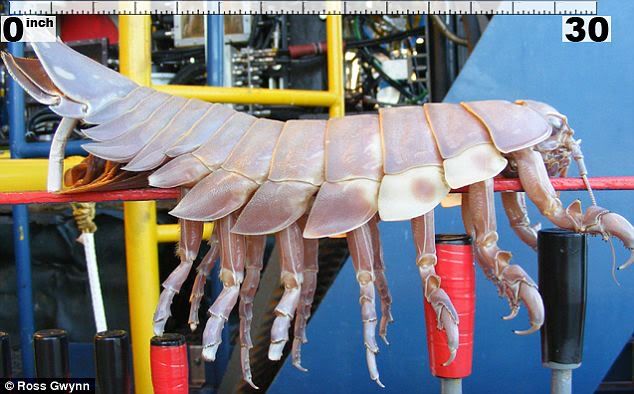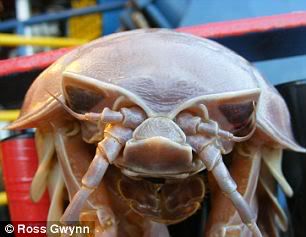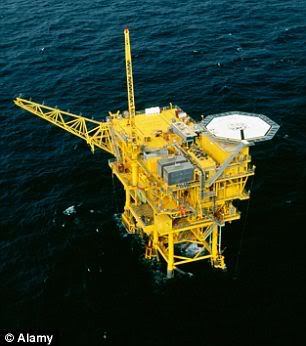-------------

From head to toe, I'm two and a half feet long (30 inches). This giant isopod was found clinging to a submarine being used by oil contractors


The unexpected visitor hitched a ride on a submarine sent from a rig in the Gulf of Mexico. The creature is a cousin of the humble woodlouse (above) who measures a mere 0.6 of an inch.What you lookin' at? The bathynomus giganteus, seen head on

The creature is a cousin of the humble woodlouse (above) who measures a mere 0.6 of an inch
This deep sea creepy-crawly gave oil workers a fright, after the unexpected visitor hitched a ride on a submarine sent from a rig in the Gulf of Mexico.
The beast normally lives 8,500ft under water and this specimen is thought to be the largest giant isopod ever found at this depth.
Questions were raised over its authenticity because of the release date of pictures - April Fool's Day. However experts have been quick to verify the find.
I've seen the pictures, and they are real, and they really do get that big,’ said Craig McClain, assistant director of science for the National Evolutionary Synthesis Center in North Carolina. 'It's definitely not an April Fool's joke.
'It's an isopod,' McClain explained. 'It's like the rolypolys or pillbugs that you find in your garden. It's the same group of animals.
'They're really common in the deep water in the Gulf of Mexico,' he added.
Called the Bathynomus Giganteus, it is a super-sized cousin of the humble woodlouse.
The one in this picture purports to be 2.5ft long - an astonishing figure considering the average specimen if half that length.
Its legs are arranged in seven pairs, and its front two are able to manipulate and bring food to its four sets of jaws. It is a scavenger that feeds on dead whales, fish and shrimp.
The species is abundant in the cold, deep waters of the Atlantic and Pacific oceans and is a good example of deep-sea gigantism.
Many deep-sea crustaceans and invertebrates tend to be larger than their shallow-water counterparts.
It is not yet known whether this is due to the colder temperature, higher pressure or scarcer food resources.
‘I've seen the pictures, and they are real, and they really do get that big,’ said Craig McClain, assistant director of science for the National Evolutionary Synthesis Center in North Carolina. 'It's definitely not an April Fool's joke.
'It's an isopod,' McClain said. 'It's like the rolypolys or pillbugs that you find in your garden. It's the same group of animals.
'They're really common in the deep water in the Gulf of Mexico,' he added.



